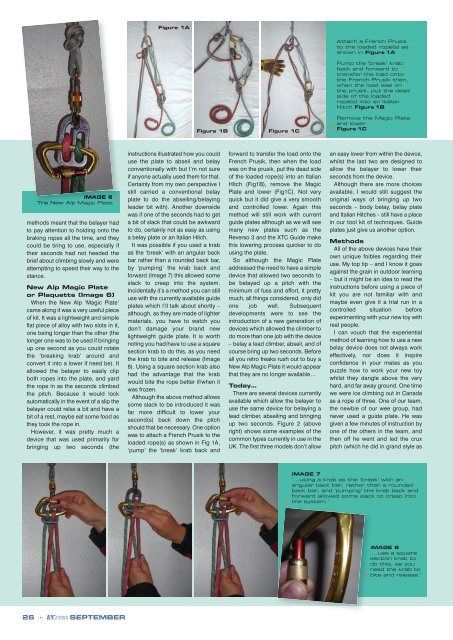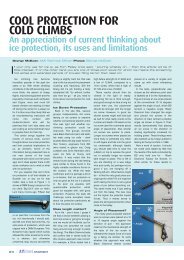WHAT'S SO MAGIC ABOUT MAGIC PLATES? - Glenmore Lodge
WHAT'S SO MAGIC ABOUT MAGIC PLATES? - Glenmore Lodge
WHAT'S SO MAGIC ABOUT MAGIC PLATES? - Glenmore Lodge
You also want an ePaper? Increase the reach of your titles
YUMPU automatically turns print PDFs into web optimized ePapers that Google loves.
IMAGE 6 ▲<br />
The New Alp Magic Plate<br />
methods meant that the belayer had<br />
to pay attention to holding onto the<br />
braking ropes all the time, and they<br />
could be tiring to use, especially if<br />
their seconds had not heeded the<br />
brief about climbing slowly and were<br />
attempting to speed their way to the<br />
stance.<br />
New Alp Magic Plate<br />
or Plaquette (Image 6)<br />
When the New Alp ‘Magic Plate’<br />
came along it was a very useful piece<br />
of kit. It was a lightweight and simple<br />
flat piece of alloy with two slots in it,<br />
one being longer than the other (the<br />
longer one was to be used if bringing<br />
up one second as you could rotate<br />
the ‘breaking krab’ around and<br />
convert it into a lower if need be). It<br />
allowed the belayer to easily clip<br />
both ropes into the plate, and yard<br />
the rope in as the seconds climbed<br />
the pitch. Because it would lock<br />
automatically in the event of a slip the<br />
belayer could relax a bit and have a<br />
bit of a rest, maybe eat some food as<br />
they took the rope in.<br />
However, it was pretty much a<br />
device that was used primarily for<br />
bringing up two seconds (the<br />
26 ... AMInews SEPTEMBER<br />
Figure 1A<br />
Figure 1B<br />
instructions illustrated how you could<br />
use the plate to abseil and belay<br />
conventionally with but I’m not sure<br />
if anyone actually used them for that.<br />
Certainly from my own perspective I<br />
still carried a conventional belay<br />
plate to do the abseiling/belaying<br />
leader bit with). Another downside<br />
was if one of the seconds had to get<br />
a bit of slack that could be awkward<br />
to do, certainly not as easy as using<br />
a belay plate or an Italian Hitch.<br />
It was possible if you used a krab<br />
as the ‘break’ with an angular back<br />
bar rather than a rounded back bar,<br />
by ‘pumping’ the krab back and<br />
forward (Image 7) this allowed some<br />
slack to creep into the system.<br />
Incidentally it’s a method you can still<br />
use with the currently available guide<br />
plates which I’ll talk about shortly –<br />
although, as they are made of lighter<br />
materials, you have to watch you<br />
don’t damage your brand new<br />
lightweight guide plate. It is worth<br />
noting you had/have to use a square<br />
section krab to do this, as you need<br />
the krab to bite and release (Image<br />
8). Using a square section krab also<br />
had the advantage that the krab<br />
would bite the rope better if/when it<br />
was frozen.<br />
Although the above method allows<br />
some slack to be introduced it was<br />
far more difficult to lower your<br />
second(s) back down the pitch<br />
should that be necessary. One option<br />
was to attach a French Prusik to the<br />
loaded rope(s) as shown in Fig 1A,<br />
‘pump’ the ‘break’ krab back and<br />
Figure 1C<br />
forward to transfer the load onto the<br />
French Prusik, then when the load<br />
was on the prusik, put the dead side<br />
of the loaded rope(s) into an Italian<br />
Hitch (Fig1B), remove the Magic<br />
Plate and lower (Fig1C). Not very<br />
quick but it did give a very smooth<br />
and controlled lower. Again this<br />
method will still work with current<br />
guide plates although as we will see<br />
many new plates such as the<br />
Reverso 3 and the XTC Guide make<br />
this lowering process quicker to do<br />
using the plate.<br />
So although the Magic Plate<br />
addressed the need to have a simple<br />
device that allowed two seconds to<br />
be belayed up a pitch with the<br />
minimum of fuss and effort, it pretty<br />
much, all things considered, only did<br />
one job well. Subsequent<br />
developments were to see the<br />
introduction of a new generation of<br />
devices which allowed the climber to<br />
do more than one job with the device<br />
– belay a lead climber, abseil, and of<br />
course bring up two seconds. Before<br />
all you retro freaks rush out to buy a<br />
New Alp Magic Plate it would appear<br />
that they are no longer available…<br />
Today…<br />
There are several devices currently<br />
available which allow the belayer to<br />
use the same device for belaying a<br />
lead climber, abseiling and bringing<br />
up two seconds. Figure 2 (above<br />
right) shows some examples of the<br />
common types currently in use in the<br />
UK. The first three models don’t allow<br />
▲<br />
▲<br />
Attach a French Prusik<br />
to the loaded rope(s) as<br />
shown in Figure 1A<br />
Pump the ‘break’ krab<br />
back and forward to<br />
transfer the load onto<br />
the French Prusik then,<br />
when the load was on<br />
the prusik, put the dead<br />
side of the loaded<br />
rope(s) into an Italian<br />
Hitch Figure 1B<br />
Remove the Magic Plate<br />
and lower<br />
Figure 1C<br />
an easy lower from within the device,<br />
whilst the last two are designed to<br />
allow the belayer to lower their<br />
seconds from the device.<br />
Although there are more choices<br />
available, I would still suggest the<br />
original ways of bringing up two<br />
seconds – body belay, belay plate<br />
and Italian Hitches – still have a place<br />
in our tool kit of techniques. Guide<br />
plates just give us another option.<br />
Methods<br />
All of the above devices have their<br />
own unique foibles regarding their<br />
use. My top tip – and I know it goes<br />
against the grain in outdoor learning<br />
– but it might be an idea to read the<br />
instructions before using a piece of<br />
kit you are not familiar with and<br />
maybe even give it a trial run in a<br />
controlled situation before<br />
experimenting with your new toy with<br />
real people.<br />
I can vouch that the experiential<br />
method of learning how to use a new<br />
belay device does not always work<br />
effectively, nor does it inspire<br />
confidence in your mates as you<br />
puzzle how to work your new toy<br />
whilst they dangle above the very<br />
hard, and far away ground. One time<br />
we were ice climbing out in Canada<br />
as a rope of three. One of our team,<br />
the newbie of our wee group, had<br />
never used a guide plate. He was<br />
given a few minutes of instruction by<br />
one of the others in the team, and<br />
then off he went and led the crux<br />
pitch (which he did in grand style as<br />
IMAGE 7<br />
‘...using a krab as the ‘break’ with an<br />
angular back bar, rather than a rounded<br />
back bar, and ‘pumping’ the krab back and<br />
forward allowed some slack to creep into<br />
the system.’<br />
▲<br />
IMAGE 8<br />
‘...use a square<br />
section krab to<br />
do this, as you<br />
need the krab to<br />
bite and release.’



